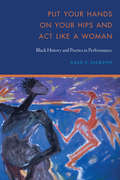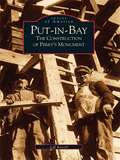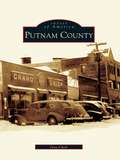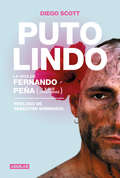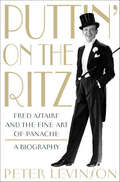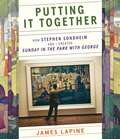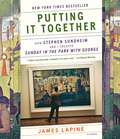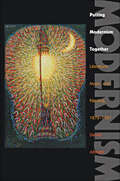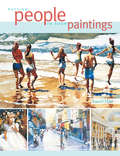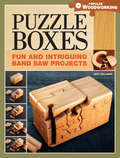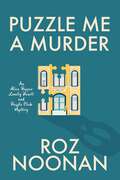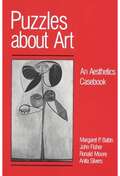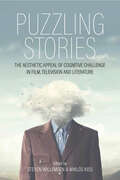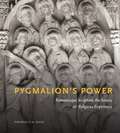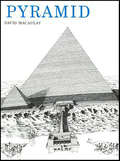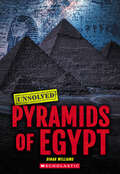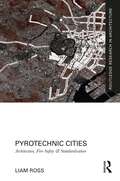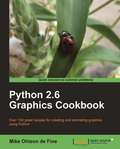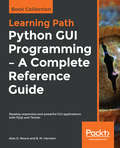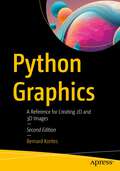- Table View
- List View
Put Your Hands on Your Hips and Act Like a Woman: Black History and Poetics in Performance
by Gale P. JacksonIn a gathering of griot traditions fusing storytelling, cultural history, and social and literary criticism, Put Your Hands on Your Hips and Act Like a Woman &“re-members&” and represents how women of the African diaspora have drawn on ancient traditions to record memory, history, and experience in performance. These women&’s songs and dances provide us with a wealth of polyphonic text that records their reflections on identity, imagination, and agency, providing a collective performed autobiography that complements the small body of pre-twentieth-century African and African American women&’s writing. Gale P. Jackson engages with a range of vibrant traditions to provide windows into multiple discourses as well as &“new&” and old paradigms for locating the history, philosophy, pedagogy, and theory embedded in a lineage of African diaspora performance and to articulate and address the postcolonial fragmentation of humanist thinking. In lyrically interdisciplinary movement, across herstories, geographies, and genres, cultural continuities, improvisation, and transformative action, Put Your Hands on Your Hips and Act Like a Woman offers a fresh perspective on familiar material and an expansion of our sources, reading, and vision of African diaspora, African American, and American literatures.
Put Your Stamp on It
by Meagan LewisStationery lovers, paper crafters, hand-printing enthusiasts and anyone looking to make personalized gifts will love the simple, colorful projects found in Put Your Stamp On It. Irresistibly cheerful, this book offers step-by-step instructions for hand-stamped gift wrap, tea towels, totes, aprons, and even hair accessories made with reverse printing, layering, borders, and more! Charming illustrations and vibrant photography inspire an endless variety of stamped creations. Best of all, the book includes directions for carving handmade rubber stamps to print on wood, fabric, and paper for a truly personal touch. So go ahead--put your stamp on it!
Put-In-Bay: The Construction of Perry's Monument (Images of America)
by Jeff Kissell"We have met the enemy and they are ours. . . ." So wrote Commodore Oliver Hazard Perry to General William Henry Harrison following his decisive victory over a British fleet at the Battle of Lake Erie. Perry's victory served as a catalyst both for this battle and for ending hostilities in the Old Northwest Theater of the War of 1812. Captured here in over 200 vintage images from the Monument archives, is a pictorial and technical record of how a monument befitting this naval victory and the resulting peace became a reality.During the remainder of his life, the country heralded Perry as a national hero whose bravery and fortitude enabled the U.S. to win, or gain an honorable peace from, its war with England. A deserving result of this victory was creation of a monument to honor Perry and his men. The story of the construction of the monument is as thrilling as the bravery that inspired it-seen here are the original photographs taken by prominent Put-in-Bay photographer G. Otto Herbster, capturing the builders, architects, mishaps, and triumphs that occurred during the construction of one of Ohio's most revered treasures.
Putnam County
by Guy CheliPutnam County, located fifty miles north of New York City and one hundred miles south of Albany, was an important site during the American Revolution and the Civil War. With the advent of the railroad, the county became an important hub for travelers heading to Boston and points north. By the mid-1800s, thousands of workers immigrated here to undertake the enormous task of building dams and reservoirs for New York City's drinking water. A popular vacation destination of past decades, Putnam County today retains much of its original charm and rural flavor.
Puto lindo: La vida de Fernando Peña (y sus criaturas)
by Diego ScottDiego Scott, productor y testigo privilegiado, reconstruye la vida de Fernando Peña y propone recordar a un tipo con un talento descomunal que rompió las estructuras de la radio, el teatro y la televisión de la mano de La Mega, Palito, Roberto Flores, Sabino, Dick Alfredo, Milagritos y Martín Revoira Lynch. A través de la memoria de sus amigos y colaboradores, Diego Scott, productor y testigo privilegiado, reconstruye la vida de Fernando Peña y sus entrañables e inolvidables criaturas. Nos propone recordar a un tipo con una capacidad de observación descomunal que le permitió desarrollar su inmenso talento. Los excesos, la generosidad, la droga, el sexo y la inteligencia fueron solo la punta del iceberg de una personalidad absolutamente sensible que cambió y rompió con todos los formatos de la radio, el teatro y la televisión de la mano de La Mega, Palito, Roberto Flores, Sabino, Dick Alfredo, Milagritos y Martín Revoira Lynch. Como dice Sebastián Wainraich en el prólogo, este libro permite "visitar a Fernando Peña. Sentirlo vivo de nuevo. Traerlo un rato de la muerte para recordarnos que Fernando fue real y que todo lo que pasó y nos pasó con él fue de verdad". Lleno de nostalgia, el libro pone en primer plano nuevamente la voz de Peña y la intimidad de sus últimos días por esta vida que no le resultó fácil: "La gente gay tiene que actuar mucho. Es muy difícil: tu madre te rechaza, tu padre te hace problema, la sociedad, los amigos... entonces tenés que actuar de varias cosas".
Puttin' On the Ritz: Fred Astaire and the Fine Art of Panache, A Biography
by Peter LevinsonFred Astaire defined elegance on the dance floor. With white tie, tails and a succession of elegant partners - Ginger Rogers, Cyd Charisse, Rita Hayworth, Eleanor Powell, Judy Garland and others - he created an indelible image of the Anglo bon vivant. His origins, though, were far more humble: Born in Omaha, Nebraska, Fred Astaire came from Midwestern stock that partially had its origin in the late nineteenth century Jewish communities of Austria. At first, he played second fiddle in vaudeville to his sister, Adele; however, once he learned how to tap and bought his first Brooks Brothers suit, the game changed. How did he transform himself from a small town Nebraska boy into the most sophisticated man ever to dance across a dance floor? In this comprehensive new book about the life and artistry of Fred Astaire, Peter Levinson looks carefully at the entirety of Astaire's career from vaudeville to Broadway to Hollywood to television. He explores Astaire's relationships with his vivacious dance partners, his friendship with songwriters like George Gershwin and Irving Berlin and his relationship with choreographers like Hermes Pan to discover how Astaire, in effect, created his elegant persona. Astaire put his mark on the Hollywood musical, starting his career at RKO and then moving to MGM. From his long list of films, certain classics like "Swing Time", "Top Hat", "Royal Wedding" and "The Bandwagon" revolutionized the presentation of dance on film; but, he also revolutionized the television variety special with the Emmy-Award-Winning "An Evening With Fred Astaire". For 'Puttin' on the Ritz", veteran Hollywood insider, Peter Levinson interviewed over two hundred people who worked closely with Astaire such as Debbie Reynolds, Dick Van Dyke, Artie Shaw, Bobby Short, Oscar Peterson, Mel Ferrer, Betty Garrett, Joel Grey, Arlene Dahl, Michael Kidd, Betty Comden, Onna White, Margaret Whiting, Andy Williams, and others like Quincy Jones, John Travolta, and John Williams, to provide an intimate window on to his professional as well as his personal life. His new biography of Astaire is a celebration of the great era of sophistication on Broadway and in Hollywood as seen through the life of a man who learned how to put on the Ritz and become America's premiere song-and-dance-man: Fred Astaire.
Putting It Together: How Stephen Sondheim And I Created Sunday In The Park With George
by James LapinePutting It Together chronicles the two-year odyssey of creating the iconic Broadway musical Sunday in the Park with George. In 1982, James Lapine, at the beginning of his career as a playwright and director, met Stephen Sondheim, nineteen years his senior and already a legendary Broadway composer and lyricist. Shortly thereafter, the two decided to write a musical inspired by Georges Seurat’s nineteenth-century painting A Sunday Afternoon on the Island of La Grande Jatte. Through conversations between Lapine and Sondheim, as well as most of the production team, and with a treasure trove of personal photographs, sketches, script notes, and sheet music, the two Broadway icons lift the curtain on their beloved musical. Putting It Together is a deeply personal remembrance of their collaboration and friendship and the highs and lows of that journey, one that resulted in the beloved Pulitzer Prize-winning classic.
Putting It Together: How Stephen Sondheim and I Created "Sunday in the Park with George"
by James LapineA NEW YORK TIMES BESTSELLERA behind-the-scenes look at the making of the iconic musical Sunday in the Park with GeorgePutting It Together chronicles the two-year odyssey of creating the iconic Broadway musical Sunday in the Park with George. In 1982, James Lapine, at the beginning of his career as a playwright and director, met Stephen Sondheim, nineteen years his senior and already a legendary Broadway composer and lyricist. Shortly thereafter, the two decided to write a musical inspired by Georges Seurat’s nineteenth-century painting A Sunday Afternoon on the Island of La Grande Jatte. Through conversations between Lapine and Sondheim, as well as most of the production team, and with a treasure trove of personal photographs, sketches, script notes, and sheet music, the two Broadway icons lift the curtain on their beloved musical. Putting It Together is a deeply personal remembrance of their collaboration and friend - ship and the highs and lows of that journey, one that resulted in the beloved Pulitzer Prize–winning classic.
Putting Modernism Together: Literature, Music, and Painting, 1872–1927 (Hopkins Studies in Modernism)
by Daniel AlbrightA powerful introduction to modernism and the creative arts it inspired.How do you rationally connect the diverse literature, music, and painting of an age? Throughout the modernist era—which began roughly in 1872 with the Franco-Prussian War, climaxed with the Great War, and ended with a third catastrophe, the Great Depression—there was a special belligerence to this question. It was a cultural period that envisioned many different models of itself: to the Cubists, it looked like a vast jigsaw puzzle; to the Expressionists, it resembled a convulsive body; to the Dadaists, it brought to mind a heap of junk following an explosion. In Putting Modernism Together, Daniel Albright searches for the center of the modernist movement by assessing these various artistic models, exploring how they generated a stunning range of creative work that was nonetheless wound together aesthetically, and sorting out the cultural assumptions that made each philosophical system attractive. Emerging from Albright's lectures for a popular Harvard University course of the same name, the book investigates different methodologies for comparing the evolution and congruence of artistic movements by studying simultaneous developments that occurred during particularly key modernist years. What does it mean, Albright asks, that Joseph Conrad's Heart of Darkness, published in 1899, appeared at the same time as Claude Debussy's Nocturnes—beyond the fact that the word "Impressionist" has been used to describe each work? Why, in 1912, did the composer Arnold Schoenberg and the painter Vassily Kandinsky feel such striking artistic kinship? And how can we make sense of a movement, fragmented by isms, that looked for value in all sorts of under- or ill-valued places, including evil (Baudelaire), dung heaps (Chekhov), noise (Russolo), obscenity (Lawrence), and triviality (Satie)? Throughout Putting Modernism Together, Albright argues that human culture can best be understood as a growth-pattern or ramifying of artistic, intellectual, and political action. Going beyond merely explaining how the artists in these genres achieved their peculiar effects, he presents challenging new analyses of telling craft details which help students and scholars come to know more fully this bold age of aesthetic extremism.
Putting People in Your Paintings
by Laurel HartCapture the essence of people in your paintingsAdd a personal touch to you watercolors with 11 step-by-step demonstrations that cover people in a variety of scenes and situations. Award-winning artist, Laurel Hart, gives you the techniques you need to capture the living, breathing essence of people. Inside you'll find:Tips for seeing the basic shapes of your subject using lighting and shading techniquesEasy methods for successful design and compositionTechniques for translating photographs into compelling, beautiful paintingsComplete instruction for placing people in settings including cityscapes, landscapes and interiorsLaurel guides you through the process with practical tips, chapter summaries and motivational "Hart-felt insights" that will inspire you to see the beauty of your subject and transfer your emotional response to watercolor. Putting People in Your Paintings gives you all the tools you need to make your paintings come alive!
Puzzle Boxes: Fun and Intriguing Bandsaw Projects
by Jeff VollmerUnlocking the Secrets of the Puzzle Box Have you ever thought inside the box? These band-sawn boxes could be the most intriguing and fun projects you've ever made. Author Jeff Vollmer describes his boxes as key-and-slide–cut a dovetail key, cut a slider piece, cut another key, cut another slider. That's the puzzle or "combination" you use to get to the chamber or heart of the box. Then you cut out the guts of the box to create a chamber. But wait, there's more! Then you cut another box from the guts, then another box or drawer from those pieces, then another and maybe another until things get too small to handle safely. Any type wood can be used to make these boxes–wood with holes, cracks, splits, insect and wormholes, spalting and burls. Jeff calls these flaws "opportunities" to become creative. Please note that the digital version of this book does not include the accompanying DVD.
Puzzle Me a Murder (An Alice Pepper Lonely Hearts and Puzzle Club Mystery)
by Roz NoonanLibrarian Alice Pepper always had a natural talent for figuring out people and puzzles in the small Oregon town of West Hazel. But as a mystery permeates the quiet Pacific Northwestern community, murder is a challenge she&’s not prepared to solve . . . Down-on-her-luck Alice had hoped to retire before turning sixty-five, not struggle to keep her cozy home and dependable job. But even after divorce leaves her golden years a mess, the pieces always come together with a little help from her friends—a fun-loving crew who thrive on jigsaws over coffee, cocktails, and gossip. So, when it&’s time to defend close confidant Ruby Milliner, she springs into action. Only, in this case, supporting Ruby means proving she didn&’t murder her cheating husband! Ruby never wanted to kill George, although anger can make a person say questionable—and incriminating—things. And scheming, deceitful George made a lot of people angry. Alice, fiercely committed to cracking the crime, dives into a secret search to exonerate Ruby. But slimming down a massive suspect list and restoring peace to West Hazel is a real gamble. Because if successful, Alice will meet a vengeful killer whose game she doesn&’t yet know how to play.
Puzzles About Art: An Aesthetics Casebook
by John Fisher Anita Silvers Margaret Pabst Battin Ronald MooreThe first casebook for use in courses in aesthetics, Puzzles about Art provides more than 180 real and hypothetical cases that illustrate important principles and theories in the philosophy of art. With 25 illustrations as well as concrete examples from legal cases, museum experiences, newspaper articles and various media, including painting, sculpture, photography, music, drama, and film, Puzzles about Art helps students understand specific problems in the visual arts.
Puzzling Stories: The Aesthetic Appeal of Cognitive Challenge in Film, Television and Literature
by Miklós Kiss Steven WillemsenMany films and novels defy our ability to make sense of the plot. While puzzling storytelling, strange incongruities, inviting enigmas and persistent ambiguities have been central to the effects of many literary and cinematic traditions, a great deal of contemporary films and television series bring such qualities to the mainstream—but wherein lies the attractiveness of perplexing works of fiction? This collected volume offers the first comprehensive, multidisciplinary, and trans-medial approach to the question of cognitive challenge in narrative art, bringing together psychological, philosophical, formal-historical, and empirical perspectives from leading scholars across these fields.
Puzzling Stories: The Aesthetic Appeal of Cognitive Challenge in Film, Television and Literature
by Miklós Kiss Steven WillemsenMany films and novels defy our ability to make sense of the plot. While puzzling storytelling, strange incongruities, inviting enigmas and persistent ambiguities have been central to the effects of many literary and cinematic traditions, a great deal of contemporary films and television series bring such qualities to the mainstream—but wherein lies the attractiveness of perplexing works of fiction? This collected volume offers the first comprehensive, multidisciplinary, and trans-medial approach to the question of cognitive challenge in narrative art, bringing together psychological, philosophical, formal-historical, and empirical perspectives from leading scholars across these fields.
Pygmalion’s Power: Romanesque Sculpture, the Senses, and Religious Experience
by Thomas E. DalePushed to the height of its illusionistic powers during the first centuries of the Roman Empire, sculpture was largely abandoned with the ascendancy of Christianity, as the apparent animation of the material image and practices associated with sculpture were considered both superstitious and idolatrous. In Pygmalion’s Power, Thomas E. A. Dale argues that the reintroduction of architectural sculpture after a hiatus of some seven hundred years arose with the particular goal of engaging the senses in a Christian religious experience. Since the term "Romanesque" was coined in the nineteenth century, the reintroduction of stone sculpture around the mid-eleventh century has been explained as a revivalist phenomenon, one predicated on the desire to claim the authority of ancient Rome. In this study, Dale proposes an alternative theory. Covering a broad range of sculpture types—including autonomous cult statuary in wood and metal, funerary sculpture, architectural sculpture, and portraiture—Dale shows how the revitalized art form was part of a broader shift in emphasis toward spiritual embodiment and affective piety during the late eleventh and twelfth centuries.Adding fresh insight to scholarship on the Romanesque, Pygmalion’s Power borrows from trends in cultural anthropology to demonstrate the power and potential of these sculptures to produce emotional effects that made them an important sensory part of the religious culture of the era.
Pygmalion’s Power: Romanesque Sculpture, the Senses, and Religious Experience
by Thomas E. DalePushed to the height of its illusionistic powers during the first centuries of the Roman Empire, sculpture was largely abandoned with the ascendancy of Christianity, as the apparent animation of the material image and practices associated with sculpture were considered both superstitious and idolatrous. In Pygmalion’s Power, Thomas E. A. Dale argues that the reintroduction of architectural sculpture after a hiatus of some seven hundred years arose with the particular goal of engaging the senses in a Christian religious experience. Since the term “Romanesque” was coined in the nineteenth century, the reintroduction of stone sculpture around the mid-eleventh century has been explained as a revivalist phenomenon, one predicated on the desire to claim the authority of ancient Rome. In this study, Dale proposes an alternative theory. Covering a broad range of sculpture types—including autonomous cult statuary in wood and metal, funerary sculpture, architectural sculpture, and portraiture—Dale shows how the revitalized art form was part of a broader shift in emphasis toward spiritual embodiment and affective piety during the late eleventh and twelfth centuries.Adding fresh insight to scholarship on the Romanesque, Pygmalion’s Power borrows from trends in cultural anthropology to demonstrate the power and potential of these sculptures to produce emotional effects that made them an important sensory part of the religious culture of the era.
Pyramid
by David Macaulay&“The mystery of the pyramids is solved before our eyes&” in this illustrated YA guide to their construction by the Caldecott Medal-winning author (Kirkus). In Pyramid, acclaimed author and illustrator David Macaulay explores the construction of ancient Egyptian pyramids from the initial planning stages to the methods used to lift stones up to the structure&’s highest level. Through concise text and richly detailed black and white illustrations your readers are introduced not only to ancient Egyptian engineering, tools, and labor practices, but also the philosophy of life, death, and afterlife that made these awe-inspiring monuments necessary as a pharaoh&’s final resting place. "Macaulay's brilliant Pyramid shows, detail by detail, how the great pharaohs' burial places were conceived and constructed… His draftsmanship is unexcelled, and his book is pharaonic in opulence and design."—Time
Pyramids of Egypt (Unsolved)
by Dinah WilliamsDiscover the unsolved mystery of the pyramids of Egypt in this beautifully illustrated book for kids, accessible for all readers!The pyramids were built as tombs for the Egyptian Pharaohs. They are an engineering feat that have puzzled scientists and historians for centuries. How did the ancient Egyptians constructthese massive structures? This real unsolved mystery will unfold with simple text and exciting visuals. Decide for yourself with actual clues, facts, and photographs.ABOUT THIS SERIES:Take a deep dive into some of the most unbelievable but real unsolved mysteries from history with this brand-new series of books. Can someone just disappear? Is there such a thing as a buried treasure? Does Bigfoot exist? Each book in this series focuses on one unsolved mystery and describes its main events chronologically. Readers will follow along as the exciting narrative uncovers real historical clues. Multiple theories will be presented providing an opportunity for readers to draw their own conclusions. The most up-to-date facts and relevant modern-day discoveries will be included to allow for real-world connections. Perhaps you will be the one to solve an unsolved mystery!
Pyrotechnic Cities: Architecture, Fire-Safety and Standardisation (Routledge Research in Architecture)
by Liam RossThis book explores the relationship between architecture, government and fire. It posits that, through the question of fire-safety standardisation, building design comes to be both a problem for, and a tool of, government. Through a close study of fire-safety standards it demonstrates the shaping effect that architecture and the city have on the way we think about governing. Opening with an investigation into the Grenfell Tower fire and the political actors who sought to enrol it in programmes of governmental reform before contextualising the research in current literature, the book takes four city studies, each beginning with a specific historic fire: The 1654 Great Fire of Meirecki, Edo; the 1877 town fire of Lagos; the 1911 Empire Palace Theatre fire, Edinburgh; and the 2001 World Trade Centre attack, New York. Each study identifies the governmental response to the fire, safety standards and codes designed in its wake and how these new processes spread and change. Drawing on the work of sociologists John Law and Anne Marie Mol and their concept of ‘Fire Space’, it describes the way that architectural design, through the medium of fire, is an instrument of political agency. Pyrotechnic Cities is a critical investigation into these political implications, written for academics, researchers and students in architectural history and theory, infrastructure studies and governance.
Python 2.6 Graphics Cookbook
by Mike Ohlson FineThis book has recipes that show enthusiastic users how easy graphic programming can be. Simple explanations in plain English are used. The recipes are built up, in each chapter, starting as simply as possible and moving to more complex programs with which you can comfortably create 2D vector graphics and animations. You will learn how to combine both vector and photo images seamlessly! If you are looking to create animated graphics to represent real-world scenarios then this book is for you. Teachers, scholars, students, and engineers who know it is possible to make fascinating models and demonstrations but have not found a handbook that pulls it all together in one place will find what they need in this recipe bank. Basic knowledge of Python programming is required and access to the Web and Google will be useful.
Python GUI Programming - A Complete Reference Guide: Develop responsive and powerful GUI applications with PyQt and Tkinter
by Alan D. Moore B. M. HarwaniExplore Python's GUI frameworks and create visually stunning and feature-rich applications Key Features Integrate stunning data visualizations using Tkinter Canvas and Matplotlib Understand the basics of 2D and 3D animation in GUI applications Explore PyQt's powerful features to easily design and customize your GUI applications Book Description A responsive graphical user interface (GUI) helps you interact with your application, improves user experience, and enhances the efficiency of your applications. With Python, you'll have access to elaborate GUI frameworks that you can use to build interactive GUIs that stand apart from the rest. This Learning Path begins by introducing you to Tkinter and PyQt, before guiding you through the application development process. As you expand your GUI by adding more widgets, you'll work with networks, databases, and graphical libraries that enhance its functionality. You'll also learn how to connect to external databases and network resources, test your code, and maximize performance using asynchronous programming. In later chapters, you'll understand how to use the cross-platform features of Tkinter and Qt5 to maintain compatibility across platforms. You'll be able to mimic the platform-native look and feel, and build executables for deployment across popular computing platforms. By the end of this Learning Path, you'll have the skills and confidence to design and build high-end GUI applications that can solve real-world problems. This Learning Path includes content from the following Packt products: Python GUI Programming with Tkinter by Alan D. Moore Qt5 Python GUI Programming Cookbook by B. M. Harwani What you will learn Visualize graphs in real time with Tkinter's animation capabilities Use PostgreSQL authentication to ensure data security for your application Write unit tests to avoid regression when updating code Handle different signals generated on mouse clicks using QSpinBox and sliders Employ network concepts, internet browsing, and Google Maps in UI Use graphics rendering to implement animations in your GUI Who this book is for If you're an intermediate Python programmer looking to enhance your coding skills by writing powerful GUIs in Python using PyQT and Tkinter, this is an ideal Learning Path for you. A strong understanding of the Python language is a must to grasp the concepts explained in this book.
Python GUI Programming Cookbook: Develop functional and responsive user interfaces with tkinter and PyQt5, 3rd Edition
by Burkhard MeierOver 90 recipes to help you develop widgets, forms, layouts, charts, and much more using the latest features of Python 3 Key Features Use object-oriented programming to develop impressive GUIs in Python Create interesting charts to visually represent data using Matplotlib Develop GUIs with the latest versions of tkinter, PyQt5, and wxPython frameworks Book Description Python is a multi-domain, interpreted programming language that is easy to learn and implement. With its wide support for frameworks to develop GUIs, you can build interactive and beautiful GUI-based applications easily using Python. This third edition of Python GUI Programming Cookbook follows a task-based approach to help you create effective GUIs with the smallest amount of code. Every recipe in this book builds upon the last to create an entire, real-life GUI application. These recipes also help you solve problems that you might encounter while developing GUIs. This book mainly focuses on using Python's built-in tkinter GUI framework. You'll learn how to create GUIs in Python using simple programming styles and object-oriented programming (OOP). As you add more widgets and expand your GUI, you will learn how to connect to networks, databases, and graphical libraries that greatly enhance the functionality of your GUI. You'll also learn how to use threading to ensure that your GUI doesn't become unresponsive. Toward the end, you'll learn about the versatile PyQt GUI framework, which comes along with its own visual editor that allows you to design GUIs using drag and drop features. By the end of the book, you'll be an expert in designing Python GUIs and be able to develop a variety of GUI applications with ease. What you will learn Create amazing GUIs with Python's built-in tkinter module Customize GUIs using layout managers to arrange GUI widgets Advance from the typical waterfall coding style to an OOP style using Python Develop beautiful charts using the free Matplotlib Python module Use threading in a networked environment to make GUIs responsive Discover ways to connect GUIs to a MySQL database Understand how unit tests can be created and internationalize GUI Delve into the world of GUI creation using PyQt5 Who this book is for If you're a programmer or developer looking to enhance your Python skills by writing powerful GUI applications, this book is for you. Familiarity with the Python programming language is necessary to get the most out of the book.
Python Graphics: A Reference for Creating 2D and 3D Images
by B. J. KoritesUse Python's built-in features to create innovative graphics for data visualization and technical illustrations. This book goes beyond simple commands and libraries to explain how to not only display but also rotate, shade, and edit graphics for any purpose. Starting with the essential Python functions to set up a plotting space and produce 2 and 3-dimensional objects, you'll learn how to construct more complex objects, translate and rotate them, remove hidden lines, introduce shading to add realism, and project images to visualize any dataset. The final chapter includes several worked applications in science and engineering including planetary models, which you can adapt for your own use.Written for developers who want to harness Python's capabilities to fine-tune their images, Python Graphics covers the different commands for plotting dots, lines, arrows, or arcs, creating custom plotting grids, correcting distortions, adding text and labels to illustrations, manipulating arcs and circles, specify and use colors, and more. Armed with these techniques and core math skills, you'll be ready to create and customize detailed technical illustrations or data visualizations. What You'll LearnUse Python′s built-in commands for plotting, removing distortions, and rotating objectsCreate and edit 2D and 3D objectsDevelop illustrations for scientific and engineering applicationsWho This Book Is ForPython developers looking for tips on how to create illustrations and visualizations, as well as scientists, engineers, or students using Python. It assumes familiarity with vectors, matrices, geometry and trigonometry.
Python Graphics: A Reference for Creating 2D and 3D Images
by Bernard KoritesThis book shows how to use Python’s built-in graphics primitives - points, lines, and arrows – to create complex graphics for the visualization of two- and three-dimensional objects, data sets, and technical illustrations. This updated edition provides more detailed explanations where required, especially regarding Python code, and explores scientific applications to topics of contemporary importance. You’ll learn how to create any 2D or 3D object or illustration, as well as how to display images, use color, translate, rotate, shade, add shadows that are cast on other objects, remove hidden lines, plot 2D and 3D data, fit lines and curves to data sets, display points of intersection between 2D and 3D objects, and create digital art. Demonstrations are included which illustrate graphics programming techniques by example, the best way to learn a language. Also brand new to this edition are demonstrations on how to visualize electron probability clouds around a nucleus, climate change, ecological diversity, population dynamics, and resource management. Python source code, including detailed explanations, is included for all applications, making the book more accessible to novice Python programmers. After completing this book, you will be able to create compelling graphic images without being limited to functions available in existing Python libraries. What You Will Learn Create 2D and 3D graphic imagesAdd text and symbols to imagesShade 3D objectsDisplay cast shadowsUse color for maximum effectView 2D and 3D data setsFit lines and curves to data sets Who This Book Is For Python developers, scientists, engineers, and students who use Python to produce technical illustrations and display and analyze data sets. Assumes familiarity with vectors, matrices, geometry and trigonometry.
